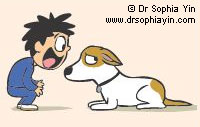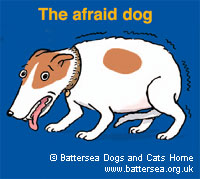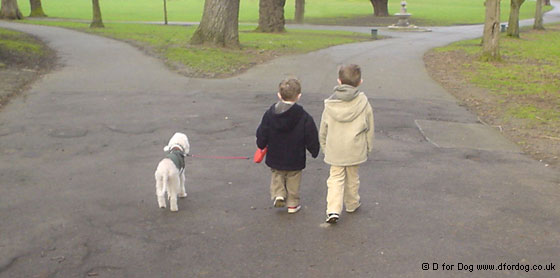Dog Etiquette and Child-Dog Interaction
Dr. Yin's blog on Kids and Dogs How Kids Should and Should Not Interact with Dogs has been doing the rounds on the internet recently, which is good news as it is simple, straight forward, sensible advice that all dog owners and parents should know about and follow.

Even if you have children but don’t own a dog, you still need to know about dog-child interactions as your child can and most likely will meet dogs, be it at the park, in the street, at a friends house. Do you let your child race over to a dog, pet it, fling their arms around it, or have you taught your child dog etiquette?
At first glance the advice looks obvious; simple common sense you may say. How many families might read this and think to themselves of course we don’t let our child bother the family dog. Yet, in reality are these rules really being followed? Do families bend the rules a bit? Does little Johnny tease the dog with food, chase him round the room or pull on his tail and you think its OK because Rover doesn't mind.
Most likely Rover does mind and is simply tolerating it. But like us, dogs probably won’t tolerate something forever. We all have our tipping point. One day the family dog may say enough is enough. They will use body language to convey their displeasure and if continued to be pushed they will probably resort to a growl. If that is not heeded, a nip or bite could well follow. Are you willing to let little Johnny continue testing Rover’s breaking point?
Sadly we have all read “dog attacks child” reports in the media. The media, by its nature, goes for short, hard hitting, sensationalised stories. In reports of dogs attacking children the media often blame the breed or at the very least heavily report on the breed of the dog and will also use phrases like “unprovoked attack”, “innocent child” and “usually loving dog” which all goes to give the impression that the attack was unprovoked, out of the blue and therefore unpreventable. Don’t fall for this media hype. Feeling helpless when it comes to preventing dog attacks will not solve the issue. Take responsibility, as a parent and as a dog owner.
Many families, after a dog attack, claim they did not see it coming or claim there was no reason for the attack. Mostly this is unlikely to be the case. Dogs give the best warnings they can, if people would only listen. And they tolerate an awful lot. Don’t take their tolerance or good nature for granted. And next time you see a dog attack reported on the news, don’t shake your head at the dog or the dog breed. Try to read between the lines and wonder just for a moment what might have led the dog to finally say enough is enough.
Dogs are fantastic loyal companions to humans but they are still dogs. When a dog shows anger, anxiety or discomfort or growls a warning, take their messages seriously and look at what prompted this. The family dog is doing his best to live in our world, by our rules, putting up with our wishes and communicating to us in the best way he can, but he is still a dog.
I remember seeing a video on Youtube of a dog being incessantly chased around the room by a tot and the family laughing as the dog desperately tried to avoid the child. The owners showed no regard at all for the dog, who was being as placid as can be in the circumstances, simply trying to get away. Not once did anyone stop the child from pestering the dog. How easily that video could have turned into something horrific if that frazzled dog had finally had enough. And sadly, if or when the dog does snap, it is the dog who gets the blame by the parents, by the media and ultimately by society.
There are not many dogs, brought up in a loving way as a family pet, who will attack an adult or a child for no reason. Poorly bred, badly raised, under socialised dogs aside, the loved, well raised, thoroughly socialised, positively trained, understood and fairly treated family dog rarely resorts to aggression for no reason or with no warning.
When the dog pushed to his or her limits does give a warning sign or even a growl, how many families tell the child to leave the dog alone? Sadly often what happens is the dog gets told off for growling. A growl is the dog’s way of warning you. Be glad of it and use it to give you information. Your dog is doing their best to tell you that there is a problem. Ignore that warning or stifle it with ‘bad boy’ and what you have on your hands is a dog who only has a nip or bite left to give. Chastise a show of teeth or a growl and there will likely be no warning next time. The growl is approaching last resort communication from your dog. Even the most tolerant dogs have limits and when limits are reached they, like us, can become unpredictable and act out of character.

No matter how obvious you think dog etiquette rules are, they are worth revisiting and seriously considering whether they are being followed properly and consistently. So many dog attacks happen because children have not been taught how to treat a dog with doggie respect and are unaware of the basics of dog body language. We all need to make sure we are actually following these basic rules of child-dog and even adult-dog interactions. Let dogs eat and sleep in peace, give them their personal space, don’t tug on them, pull them about or get in their face. Only play dog appropriate games, don’t treat them like toys, and always treat them politely and respectfully, not by our rules or standards but by the dog’s rules and needs.
These basics of dog etiquette don’t just apply to children; they apply to all members of the family, friends, park companions and even approaching strangers. Don’t stand by while someone invades your dog’s space, no matter how well meaning they are. Stand up for your dog. Don’t put your dog in a position where they have to tolerate behaviours that are considered rude in the dog world.
Each dog varies so watch your own dog and get to know their tolerance levels, signs of discomfort and warning signs. Look for signs that your dog is feeling stressed or threatened. Some usual signs of stress or feeling threatened are looking away, lip licking, yawning or scratching, stiff body posture, and growling.
No human-dog interaction ‘rules’ can be hard and fast or applied to all dogs. Even a gentle pat to a dog that is not used to children is going to be a step too far for them. This does not make your dog bad or aggressive; it just means he is not socialised with or used to children or not willing to tolerate children and all they entail. If you are a dog owner you also need to be mindful of the fact that a dog’s tolerances and preferences can change over time as well. So previously what the dog was happy to accept or tolerate can change with old age or due to tiredness, discomfort, pain or illness.
Although dog etiquette rules apply to adults and children alike, it is important to understand why children are particularly at risk. Children have a harder time comprehending that the dog is an animal rather than a toy. From a dog’s point of view children are small and fast moving, making high pitched noises and squeals, darting away and then far too close, prodding and poking, grabbing, pulling and teasing, unstable, wobbling unpredictable, are prone to stealing the dog’s toys and have a habit of waving food about. Also consider that you are probably pretty bad at reading a dog’s body language and your child is likely to be even worse at it.

Battersea Dogs and Cats Home have produced some very useful leaflets and publications for children, accompanied by colourful illustrations that are easy to understand. There are various leaflets dealing with safety around dogs and understanding the body language of a dog. The aim is to teach children how to read canine body language, how to tell if a dog is feeling angry, afraid or playful, how to avoid misunderstandings, how to behave appropriately around dogs, and how to interact with the family dog and any dog they meet when out and about, in the park, on the street, anywhere.
Once you have taught your child the rules of how to interact with a dog, the onus is not now on the child and the dog to behave respectably towards each other. You as the parent and/or dog owner can never take for granted the dog-child interactions that may be taking place. Make sure your dog has a safe haven where no one is allowed to bother him. It goes without saying the dog’s own bed or sleeping area should be sacrosanct. Never leave dogs and children alone. Always oversee child-dog interactions. And make sure you follow the rules too. Practice what you preach.
Dogs do a fantastic job of living in our world. Only they know how much they tolerate; it is as much as we can imagine and then some. By learning a bit more about dog etiquette and body language, we can all live together much more happily and safely.

By Jenny Prevel
© D for Dog www.dfordog.co.uk
This article belongs strictly to D for Dog and we do not authorise the copying of all or any part of it.
